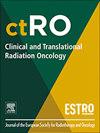SBRT治疗复发性少转移性卵巢癌:EORTC Y-ECI GCG系统综述
IF 2.7
3区 医学
Q3 ONCOLOGY
引用次数: 0
摘要
以有限的疾病负担管理复发性少转移性卵巢癌具有挑战性,需要局部治疗以实现持久控制,同时减少全身治疗暴露。立体定向全身放疗(SBRT)提供高精度和消融剂量,最大限度地减少对邻近器官的毒性。本系统综述分析了9项研究,涉及426例患者和809个SBRT治疗的病变。患者的中位年龄为61.2岁,既往接受过中位三次全身治疗。SBRT的中位剂量为40 Gy,获得了10.32个月的中位无进展生存期(PFS) (95% CI: 2.79-38.26)和78%的2年总生存率。局部结果是有希望的,目标病灶控制率为95.9%,病灶缓解率为86%。SBRT延迟了全身治疗的开始,中位时间为9.45个月,并且耐受性良好,大多数毒性轻微(CTCAE等级≤2)。报告了罕见的3级和5级胃肠道毒性。尽管有这些令人鼓舞的结果,但这些研究受到中度至重度偏倚风险、治疗方案的异质性以及SBRT剂量和分离的差异的限制。这些发现强调了SBRT作为一种有效治疗少转移性卵巢癌的潜力,但需要进一步的研究来完善策略,规范方案,并确定最有可能受益的患者亚组。人们热切期待前瞻性试验来确定SBRT在改善这一具有挑战性的临床情况中的作用。本文章由计算机程序翻译,如有差异,请以英文原文为准。
SBRT in recurrent oligometastatic ovarian cancer: An EORTC Y-ECI GCG systematic review
Managing recurrent oligometastatic ovarian cancer with a limited disease burden is challenging, requiring localized treatments to achieve durable control while reducing systemic therapy exposure. Stereotactic body radiotherapy (SBRT) offers high precision and ablative dosing, minimizing toxicity to adjacent organs. This systematic review analyzed nine studies involving 426 patients and 809 lesions treated with SBRT. Patients had a median age of 61.2 years and underwent a median of three prior systemic treatments. SBRT, delivered at a median dose of 40 Gy, achieved a pooled median progression-free survival (PFS) of 10.32 months (95 % CI: 2.79–38.26) and a 2-year overall survival rate of 78 %. Local outcomes were promising, with a target lesion control rate of 95.9 % and a lesion response rate of 86 %. SBRT delayed systemic therapy initiation, with a median time of 9.45 months, and was well tolerated, with mostly mild toxicities (CTCAE grade ≤ 2). Rare grade 3 and 5 gastrointestinal toxicities were reported. Despite these encouraging results, the studies were limited by moderate to serious risk of bias, heterogeneity in treatment protocols, and variations in SBRT dose and fractionation. These findings highlight SBRT’s potential as an effective treatment for oligometastatic ovarian cancer, but further research is needed to refine strategies, standardize regimens, and identify patient subgroups most likely to benefit. Prospective trials are eagerly awaited to establish SBRT’s role in improving outcomes for this challenging clinical scenario.
求助全文
通过发布文献求助,成功后即可免费获取论文全文。
去求助
来源期刊

Clinical and Translational Radiation Oncology
Medicine-Radiology, Nuclear Medicine and Imaging
CiteScore
5.30
自引率
3.20%
发文量
114
审稿时长
40 days
 求助内容:
求助内容: 应助结果提醒方式:
应助结果提醒方式:


